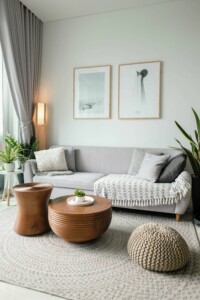
One of my favorite Feng shui stories to tell is the time our whole school went on a field trip to the Hollyhock House in the Hollywood area of Los Angeles. It is a famous Frank Lloyd Wright designed house and we went on their regular tour. Like many Frank Lloyd Wright projects, this house had numerous Feng shui flaws from an architectural stand point. It was dark, with a very narrow passage way to the front door. The tour guide even said this was done on purpose to create a “birth canal” experience.
You couldn’t tell easily what the orientation of the house was and the ceilings were oppressively low with not enough windows, just to list a few problems. Wright used to make some pretty uncomfortable furniture designs as well, including the concrete chairs we encountered in the dingy dining room! It is bewildering when individuals have referred to Frank Lloyd Wright’s homes as having good Feng shui, simply because he liked to incorporate water features in an around the homes he designed.
Our tour guide punctuated his talk with juicy bits of information about the woman who commissioned Wright to design her home, oil heiress Aline Barnsdall, with references to the personal relationship she also had with Wright. Finished in 1921, Barnsdall never felt comfortable in the very awkwardly designed master bedroom and supposedly curled up on a little couch in a step-down area of the bedroom near a balcony.
With all the drama and trauma surrounding the construction of the house and the people involved, one student blurted out that it didn’t sound like they were very happy people. The tour guide shot back that they had very interesting lives, but Master Sang whispered a little comment about how interesting lives are not necessarily happy lives.
We all know that throughout time there are famous and rich people who are totally miserable. They may suffer poor health or turbulent relationships in spite of all their affluence, power and the wild shenanigans that now get them on the cover of tabloid magazines. There is even a major house type in Feng Shui called “Double Facing.” The Double Facing house can be supportive for financial luck, but undermining for the health and relationships of the occupants.
So with Feng Shui design concepts ignored: really odd, bizarre, or extreme architecture or design is just not worth the long term affect it can have on a person. I sometimes use the analogy that it might be fun to be scared for a few minutes on a roller coaster ride, but do you want that kind of experience on a daily basis? Of course not. Living with really unbalanced surroundings may be stimulating initially, but ultimately it is a stress on your nervous and glandular system.
I have evaluated homes that were totally round, half-circles, geodesic domes, triangular or boomerang shaped, pyramids, and another Frank Lloyd Wright home in the desert that looked like a plane had crashed into their roof.
Sometimes the straight-forward square or rectangular shaped house is the safest and most stable. Flat ceilings of normal height produce the soundest sleep and parallel/ perpendicular walls allow the greatest ease for furniture placement. Yes, sometimes balance is a bit boring. Extremely large palatial homes are not appropriate for just one or two people and the house at the very top of the hill may look spectacular, but cause the occupant to be lonely or isolated. The middle-range in size and distance from others is the more balanced choice.
Even when clients ask about colors for their walls and carpeting, I steer them away from extreme colors except when I know that the room can handle that kind of energy most of the time. For example, a blood-red wall might be good in a certain part of the house most of the time, but inevitably in some cycles or years that same red wall might have a negative affect. Do I expect a person to re-paint their wall for one year? Usually not. It would be so much easier to just remove a red décor item from the room in that particular year.
When you think about extreme environments, which Feng Shui schools often categorize in classes on “yin-yang theory,” it is almost always a problem to maintain an environment that is extreme without some kind of backlash. So if creating balance is a little boring or conservative, at least there is a good reason for it.
Author: Kartar Diamond
Company: Feng Shui Solutions (R) since 1992
From the Architecture & Design Blog Series
